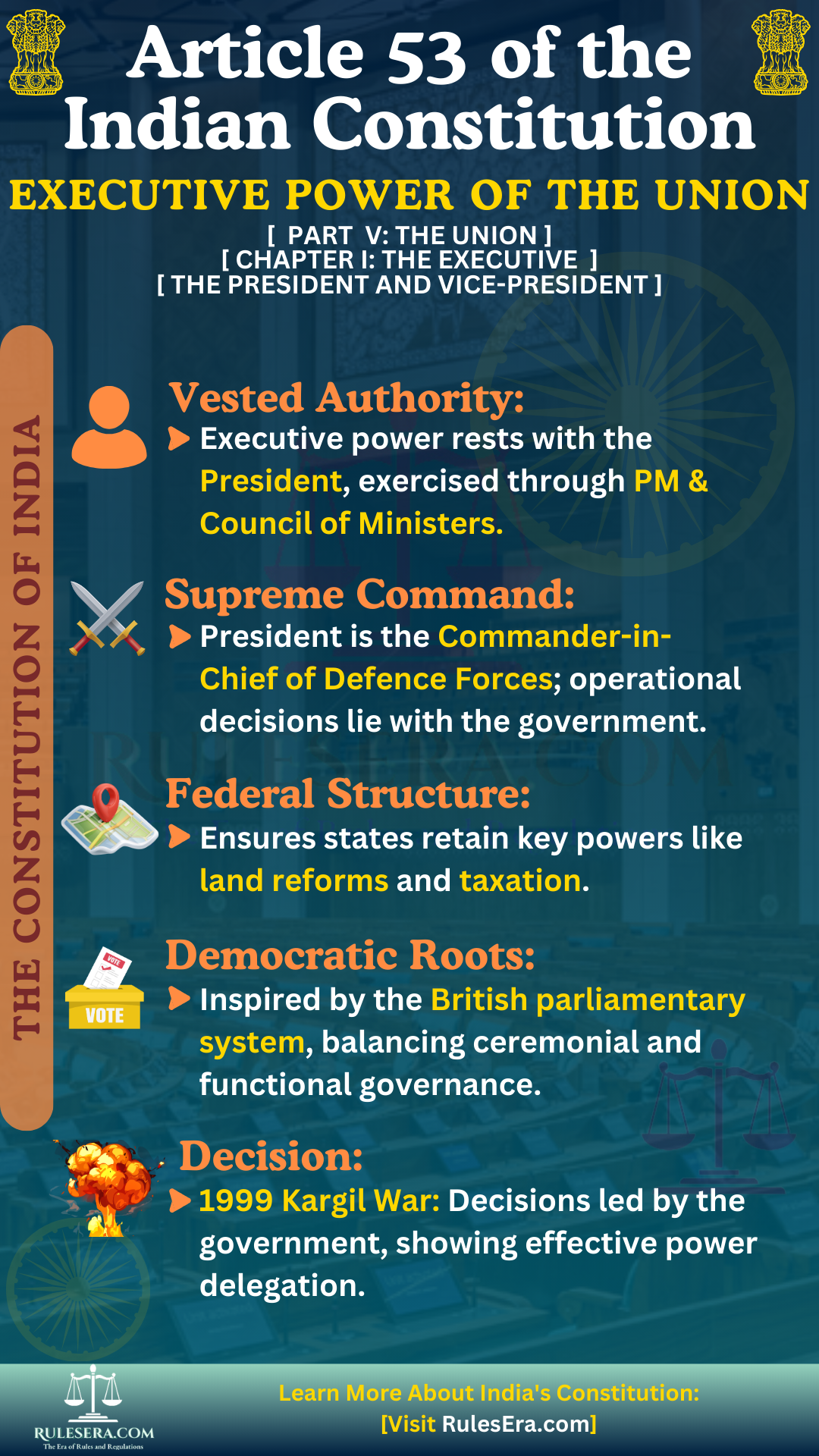Part V: The Union
Chapter I: The Executive
Article 53: Executive Power of the Union

--- Original Article ---
(1) The executive power of the Union shall be vested in the President and shall be exercised by him either directly or through officers subordinate to him in accordance with this Constitution.
(2) Without prejudice to the generality of the foregoing provision, the supreme command of the Defence Forces of the Union shall be vested in the President and the exercise thereof shall be regulated by law.
(3) Nothing in this article shall—
- (a) be deemed to transfer to the President any functions conferred by any existing law on the Government of any State or other authority; or
- (b) prevent Parliament from conferring by law functions on authorities other than the President.
Explanation
Article 53 of the Indian Constitution defines the scope and distribution of executive power within the Union of India. The article vests this power in the President, though it is exercised predominantly through officers subordinate to the President, adhering to a parliamentary form of governance where the real power lies with the Prime Minister and the Council of Ministers. The article also addresses the President's role as the supreme commander of the defense forces and sets limits on the transfer of certain functions.
Key Provisions
- Clause (1): Vested Executive Authority: While the President holds formal executive power, in practice it is exercised by the Council of Ministers led by the Prime Minister, maintaining parliamentary democracy.
- Clause (2): Supreme Command of Defence Forces: The President's ceremonial role as the commander of India’s military is vested here, with operational control managed by the Cabinet and Ministry of Defence.
- Clause (3): Restrictions on Presidential Functions: This clause prevents unintended transfers of functions to the President, ensuring a balanced distribution of authority between the Union and States.
Amendments and Real-Life Examples
- Amendments: Article 53 has not been significantly amended, but its practical application continues to reflect India's parliamentary model, where executive authority is exercised through the Council of Ministers.
- Real-Life Example: During the 1999 Kargil conflict, while the President held supreme command, military decisions were executed by the Cabinet and armed forces under the Prime Minister's leadership.
Historical Significance
Article 53 establishes a framework for executive power within India’s parliamentary system. While modeled after the British system, it ensures that executive authority resides with the elected representatives, not the President, safeguarding democratic governance.
Legislative History
Article 53, initially presented as Article 42 of the Draft Constitution on December 10, 1948, was debated extensively and finally adopted with adjustments on October 16, 1949.
Debates and Deliberations
During the debate on December 10, 1948, Prof. K.T. Shah suggested clarifying the President's role, drawing from both the British and American systems. His proposals for a more active presidential role were ultimately rejected in favor of a ceremonial head bound by parliamentary principles.
On October 16, 1949, further debates occurred on specifying the delegation of the President's powers through subordinate officers. Shri Alladi Krishnaswami Ayyar and Shri N. Gopalaswami Ayyangar defended this structure, affirming its alignment with the Government of India Act, 1935, ensuring practicality in governance.
Frequently Asked Questions (FAQs):
The executive power is vested in the President but is exercised by the Prime Minister and the Council of Ministers through the President, in line with parliamentary democracy.
No significant amendments have been made to Article 53, and it continues to operate within the structure laid out in the Constitution.